Want a deeper connection with your audience? Have you considered communicating stories visually in your marketing?
In this article, you'll discover five ways to use visual content to tell stories that engage your audience.
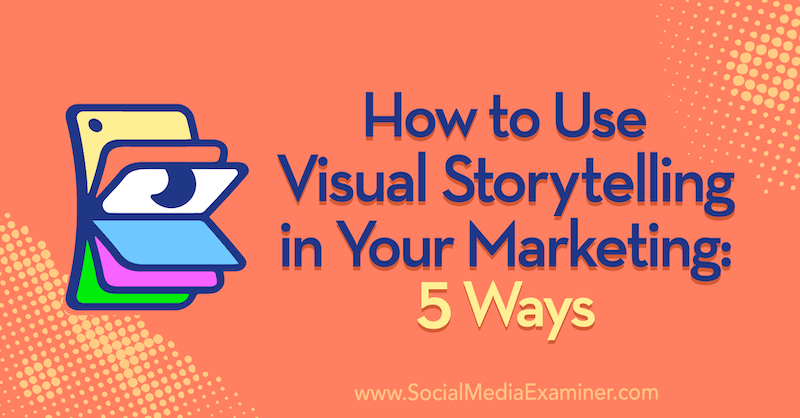
What Is Visual Storytelling?
It's common knowledge among psychologists, visual marketers, and behavioral specialists that around 93% of communication is nonverbal, hence the cliché, “A picture is worth a thousand words.”
But in a world in which brand communications are driven more than ever by visual content, new and powerful modes of visual communication are emerging all the time. In fact, 1 minute of video is worth 1.8 million words, according to Forrester Research. This makes it easy to see why audiences aren't as willing to engage with text-driven content.
Visual storytelling is a strategy for using visual content to communicate a narrative. An effective piece of visual storytelling inspires an emotional response, educates the audience, and/or guides them to a particular conclusion. Visual storytelling can take place in a single piece of content—such as a motion graphic, infographic, or social media post—or it can be achieved over the course of several connected and complementary pieces of content.
Some businesses will share the story of their founding—the inspiration for their product or service and their leaders. If your business doesn't have this kind of history to share, you may think your brand doesn't have a compelling story.
Don't worry; of course you have a story worth sharing. How will your product or service make the world a better place? How does it make life better for your customers? Tell the story of a real or hypothetical client using your product or service.
Your business has a story to tell but that story can no longer be told in long blocks of text. If you want your audience to listen, you need to harness the power of visual storytelling. Here are five ways you can do that with your visual content.
#1: Share Your Origin Story
As we've already established, there are lots of potential stories that your brand can tell. One of those narratives that holds a lot of potential for many businesses is their origin story.
This story may be about how your company was founded, why it was founded, or some combination of the two. What problems did the founder(s) see that they wanted to solve? Was there an epiphany? What challenges did the company have to overcome to get to where it is now?
The origin story is particularly suited to appearing in the form of a video or motion graphic, which can guide the viewer through a linear narrative in a more controlled way than interactive media, which tends to prioritize self-guided exploration.
That said, there really are no limits to the style in which such a video can be produced. The important thing is to find an approach that's consistent with your brand.
Let's take a look at two starkly different examples of visual storytelling employed to tell an origin story through video. It's easy to see how these reflect the businesses they're profiling.
Get World-Class Marketing Training — All Year Long!
Are you facing doubt, uncertainty, or overwhelm? The Social Media Marketing Society can help.
Each month, you’ll receive training from trusted marketing experts, covering everything from AI to organic social marketing. When you join, you’ll also get immediate access to:
- A library of 100+ marketing trainings
- A community of like-minded marketers
- Monthly online community meetups
- Relevant news and trends updates
How could the LEGO story be anything other than animated?
.
Still, the brilliance isn't only in the choice of animation but also in the fact that this motion graphic is targeted to those most likely to use the product: Children. The motion graphic is framed almost like a fairy tale, such that children would be just as likely to watch it as adults. And their reaction is likely to be akin to enchantment, which is exactly the point. A brand's origin story should inspire a more intimate connection with the viewer.
Burberry took a more cinematic approach to telling its origin story, using high-quality cinematography, braided imagery, musical overlay, and quick cuts akin to a film trailer:
.
The resulting video evokes the highly stylized, high-quality product itself, as well as the lifestyle that its wearers would probably not mind emulating.
Sure, videos and motion graphics are great media for telling your business's origin story but they're not the only way. If you have a rich 50-year history like the National Endowment for the Arts, a video that encompasses everything might prove way too long and detailed, risking losing the audience's attention. So you might instead opt for an interactive approach to visual storytelling.
In the NEA's case, they chose an interactive timeline that users could explore at their own pace.
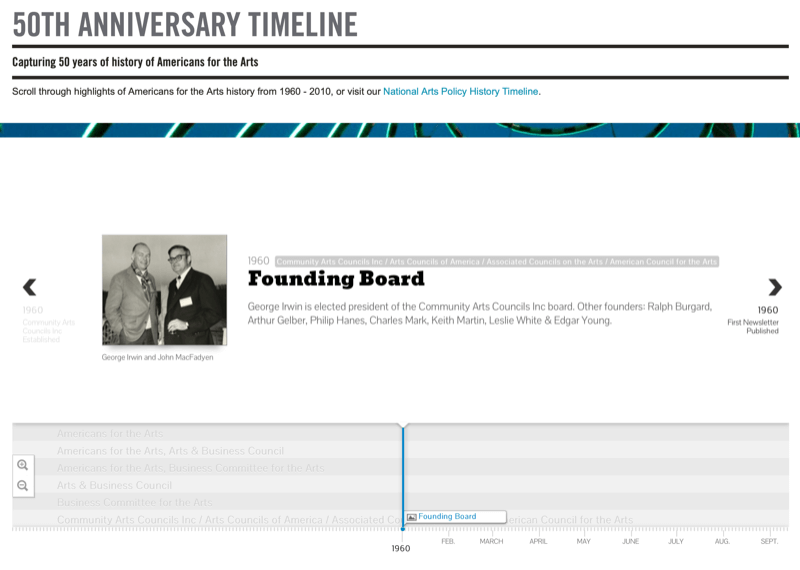
This approach empowers the user to follow what interests them most—to co-create the story. Given that interactive content can greatly boost conversion rates, it's a powerful tool for driving real engagement.
If you choose to use video or animated video to tell your brand's origin story, a new problem arises: How can you make optimum use of these videos across all of your social channels? After all, on Instagram alone, the maximum video length for a post is 60 seconds, while it's only 15 seconds for Instagram Stories. These limits vary from platform to platform. And it's not just video length you have to worry about but also varying dimensions.
There are multiple approaches to solving this conundrum, and practically all of them have the added bonus of making your video go further. That is, there are multiple ways to repurpose a video or motion graphic for social media and other promotional purposes so you can get more return on your investment.
To visualize this, the LEGO video is populated with some pretty important characters, including the founder of the company himself, Ole Kirk Christiansen. When Christiansen fell upon hard times, he leveraged his carpentry skills to start building toys.
These characters can be reused again and again across LEGO's promotional materials. They might be guides that lead people around a landing page or illustrations for an interactive infographic that tells the narrative differently. On social media you can tell a story in bits and pieces, focusing on individual characters in short GIFs, MP4s that are just snippets of the longer video, or in stills from the video.
For instance, imagine the following screenshot as a Twitter or Instagram post accompanied by the text, “Did you know that LEGO's founder started the company making toys for his four sons?” You might then try to spark a conversation with a question: “What was your favorite toy as a child? (Besides LEGO, of course!)”
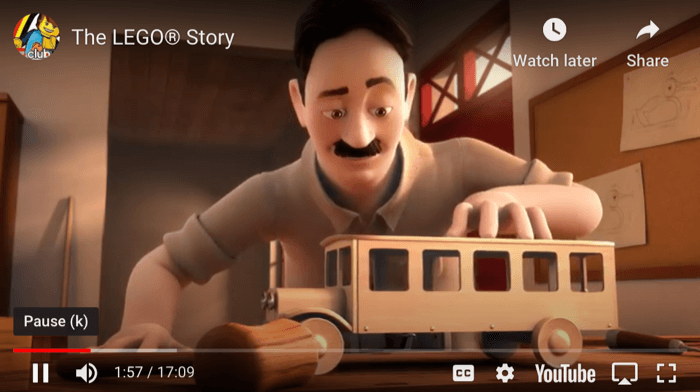
Just remember, you'll need to adjust the dimensions of the still or screenshot depending on the platform on which it's going to appear. To illustrate, for a typical square Instagram feed post, you may set the ratio as 1:1.
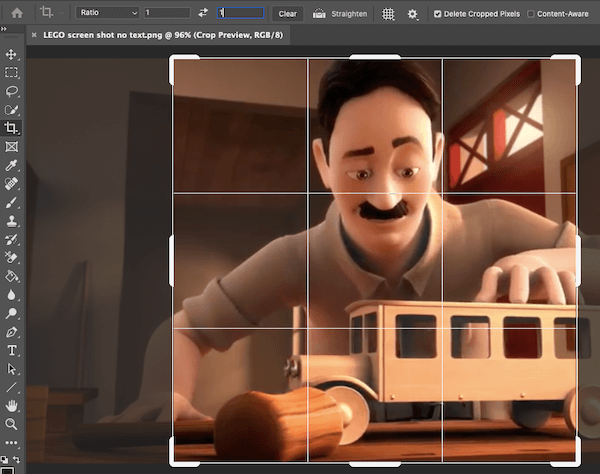
By repurposing your video, you can quickly and easily create multiple assets that will work across social channels and continue to drive traffic to your video over the long term.
You can take the same approach to sharing not only other stills but also data visualizations and short-form clips from the longer video. This will give it more traction over a longer period of time and ensure that the video is being used to its maximum potential across your social channels.
#2: Communicate Your Company's Aspirations
Even if your business doesn't have a particularly compelling origin story to share, you can still use the power of visual storytelling by illustrating what your business hopes to achieve. These aspirational narratives look beyond the goal of selling a product or service and focus on how that product or service or the business as a whole will make the world a better place.
Sharing a narrative of corporate responsibility—about how you're giving back to your community or fighting for a worthy cause—is particularly effective with Generation Z, which comprises 32% of the world's population, and thus is a significant (and growing) proportion of almost any business's target audience.
As many marketing experts have already observed, Gen Z tends to prioritize brands that are socially conscious and work to give back to their communities. The success of such marketing efforts as the #LikeaGirl campaign from Always puts this in sharp relief.

Discover Proven Marketing Strategies and Tips
Want to go even deeper with your marketing? Check out the Social Media Marketing Podcast! Publishing weekly since 2012, the Social Media Marketing Podcast helps you navigate the constantly changing marketing jungle, with expert interviews from marketing pros.
But don’t let the name fool you. This show is about a lot more than just social media marketing. With over 600 episodes and millions of downloads each year, this show has been a trusted source for marketers for well over a decade.
So if your company is doing something inspiring that will make the world a better place, it's time to share that story. Ben and Jerry's is a great example of a brand that, instead of sharing their past, looks to pioneer a better future on multiple fronts. Ben and Jerry's brings their mission of sustainable foods and responsibly sourced agriculture to the foreground in their marketing materials:
.
#3: Deliver Educational and Instructional Content
If you want to both capture and keep your audience's attention, you need to offer something of real value to them. That's why educational and instructional content can drive huge engagement on social media. In fact, 77% of B2B marketers are already using educational content to reach their audiences.
For instance, when insurance company PEMCO wanted to connect with two key target audiences—homeowners 35 and older, and a general group of people older than 20—they decided to develop a series of 15 short motion graphics to educate their audiences on home maintenance, safety, and other useful topics. The most popular of these motion graphics saw 12x more shares than their average posts.
Here's one example from that visual storytelling campaign, a motion graphic on planning family fire drills:
.
Nonprofits find educational content to be particularly useful too. Entrepreneurial service organization digitalundivided wanted to educate their audience on America's long history of Black and Latinx women entrepreneurs so they opted to design a motion graphic to highlight a few influential figures as part of their #WeAreLimitless campaign.
They also divided that motion graphic into several short-form MP4s, each highlighting one woman, that they could share across their social channels. Here's one of them:
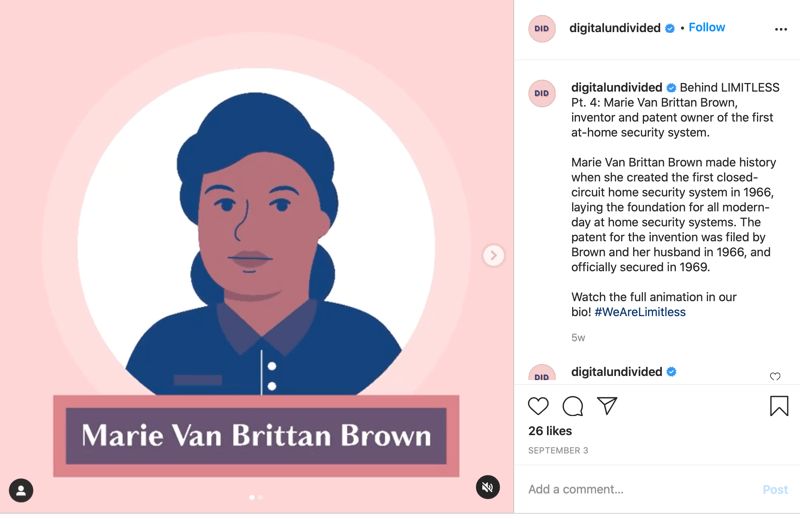
Still, this doesn't mean digitalundivided couldn't or shouldn't share the full motion graphic as well. If you've created a motion graphic or video longer than a minute that you'd like to post on Instagram, there's another option. If you post it as an IGTV video post, it will keep playing if audiences agree to keep watching (by clicking “Keep Watching on IGTV” after they've watched several seconds of the preview).
Here's how to post a longer video as an IGTV video. First, upload your video to Instagram as you would any other post. Then tap Next.
If your video is longer than a minute, you'll be prompted to choose between posting a short video and a long video. Choose the Long Video option.
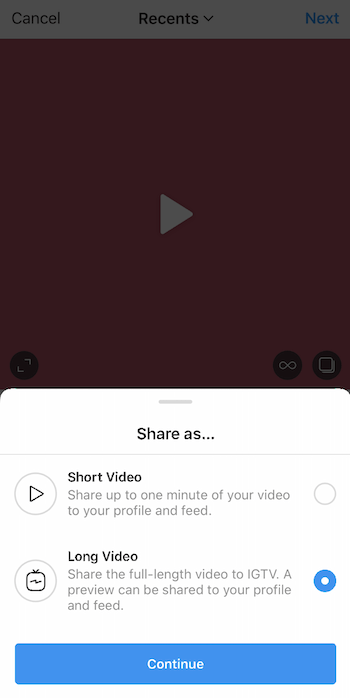
Now choose a frame from the video to use as the cover of your IGTV video. This isn't the same as the cover that will appear on your Instagram feed but it will form the basis of that image. So choose something that will work in a square format later on.
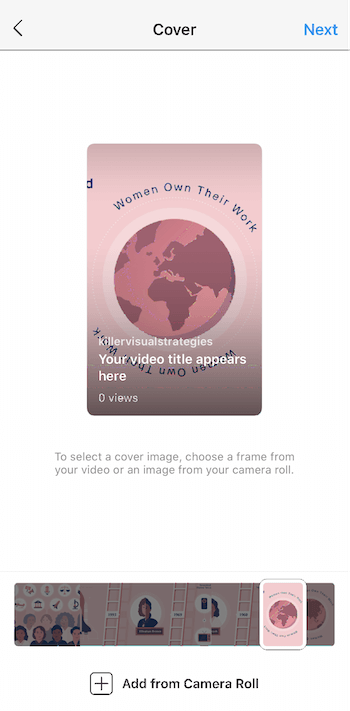
After you tap Next, you'll need to choose a title and description for your post. The description will function much as any other Instagram post copy will. The title will appear just before it in your feed.

At this stage, make sure you tap Edit Profile Cover. This is where you'll be able to adjust and re-center the IGTV cover you chose a few steps ago to optimize how it appears in your feed.

Now hit Post and away it goes!
Just remember, publishing the whole video doesn't prevent you from sharing shorter snippets like those above. On the contrary, it allows you to get more traction from a single video.
#4: Illustrate Product Creation From Start to Finish
For some businesses, the production of their product is a whole story by itself. And there are a lot of potential reasons for sharing this story. Perhaps it involves an innovative technique or strategy. Perhaps you're sourcing from sustainable materials or focusing on fair trade or other socially conscious practices. The possibilities really are endless.
When 3D printing company Carbon partnered with the sports equipment experts at Riddell, they wanted to create a football helmet that would not only be a custom fit for the wearer but safer too. The short-form animated videos they developed for their social media channels were also shared on a custom landing page designed to promote the collaboration.
Carbon was able to showcase firsthand the kind of expertise that goes into making each of their products, as well as show off what makes Carbon's 3D printing technology truly unique. Here's one of the resulting videos:
Videos and motion graphics aren't the only visual media that can effectively illustrate the process of product development and creation. Infographics or mini-infographics for social media are also a great choice. In fact, if you produce a video like the Carbon/Riddell piece above, you can repurpose the artwork into still images that work across all of your social channels so you can tell your story in multiple ways, ensuring that it appeals to all of your audiences.
#5: Highlight Customer Stories
Visual storytelling isn't always about putting your brand in the spotlight. Sometimes you want to empower your audiences and customers to tell stories of their own.
Encouraging user-generated content (UGC) on your social channels has huge marketing potential. After all, 70% of Generation Z say that YouTube influencers are more relatable than celebrities. Many of your customers are seeking authenticity in the form of real-life stories, not just stories that are curated by brands.
There are many ways to encourage and share UGC across social media. Visual content of this type seems to be the most effective by far, as photos of real people, cute pets, and real examples of your brand out in the world create a more human experience.
During the pandemic, UPS has made ample—and powerful—use of UGC by sharing the many notes and gifts of thanks that have been left for their drivers. This content works in tandem with the driver-operated Instagram and Facebook pages, UPS Dogs, which share photos of cute dogs along drivers' routes. This type of content regularly generates thousands of likes on Instagram, usually receiving twice as many likes as brand-generated posts.
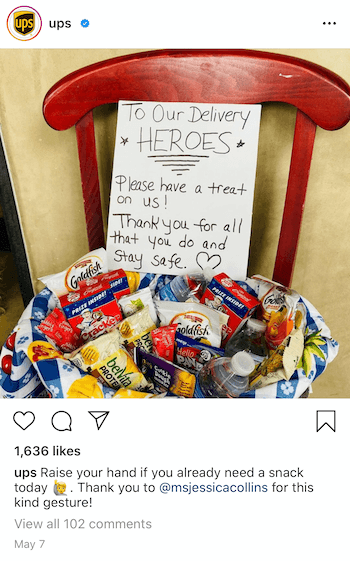
So ask your customers to share images of their experience with your product or service. Offering a reward—such as entering all images in a raffle to win a coupon or free product—can incentivize this kind of sharing. The more people who share, the more others will want to do the same.
Conclusion
Today's businesses need to tell compelling stories and this is achieved most effectively through the use of visual content. These stories can take place in an instant—in a single, compelling social media post—or over time via multiple interwoven visual assets that together form a larger narrative arc.
The right approach for your business depends on what you want to achieve for your brand as a whole and in particular campaigns. Set clear goals and define your target audiences and you'll be able to find the right visual medium to bring your story to life.
What do you think? How might you use these visual storytelling techniques in your own marketing? Share your thoughts in the comments below.
More articles on social media visuals:
- Learn how to change landscape video into square video using your mobile device.
- Discover how to create better visuals for your marketing.
- Find four free tools to create images for your marketing.
Attention Agency Owners, Brand Marketers, and Consultants

Introducing the Marketing Agency Show–our newest podcast designed to explore the struggles of agency marketers.
Join show host and agency owner, Brooke Sellas, as she interviews agency marketers and digs deep into their biggest challenges. Explore topics like navigating rough economic times, leveraging AI, service diversification, client acquisition, and much more.
Just pull up your favorite podcast app, search for Marketing Agency Show and start listening. Or click the button below for more information.

